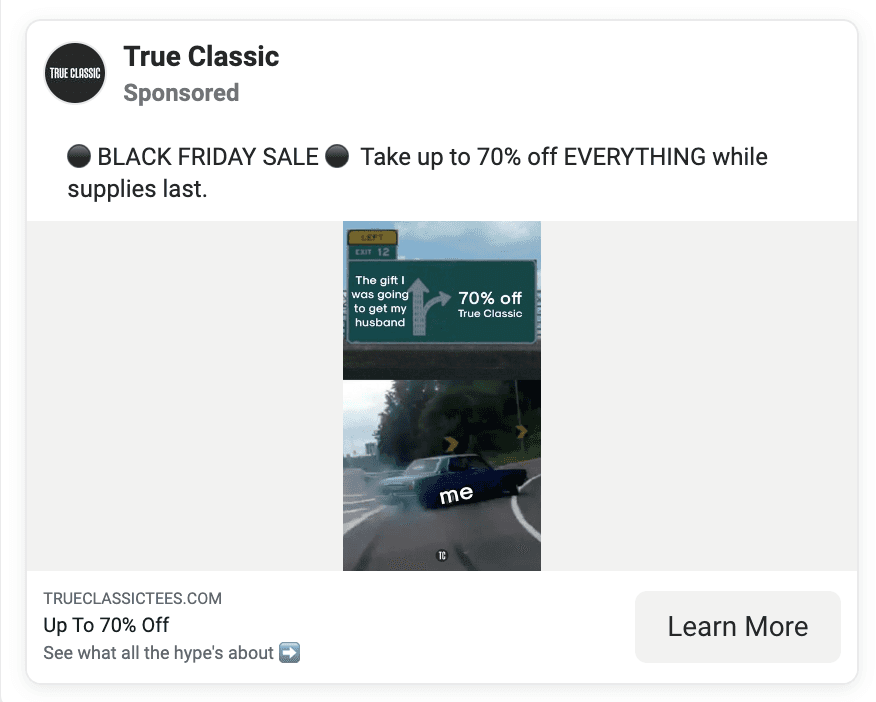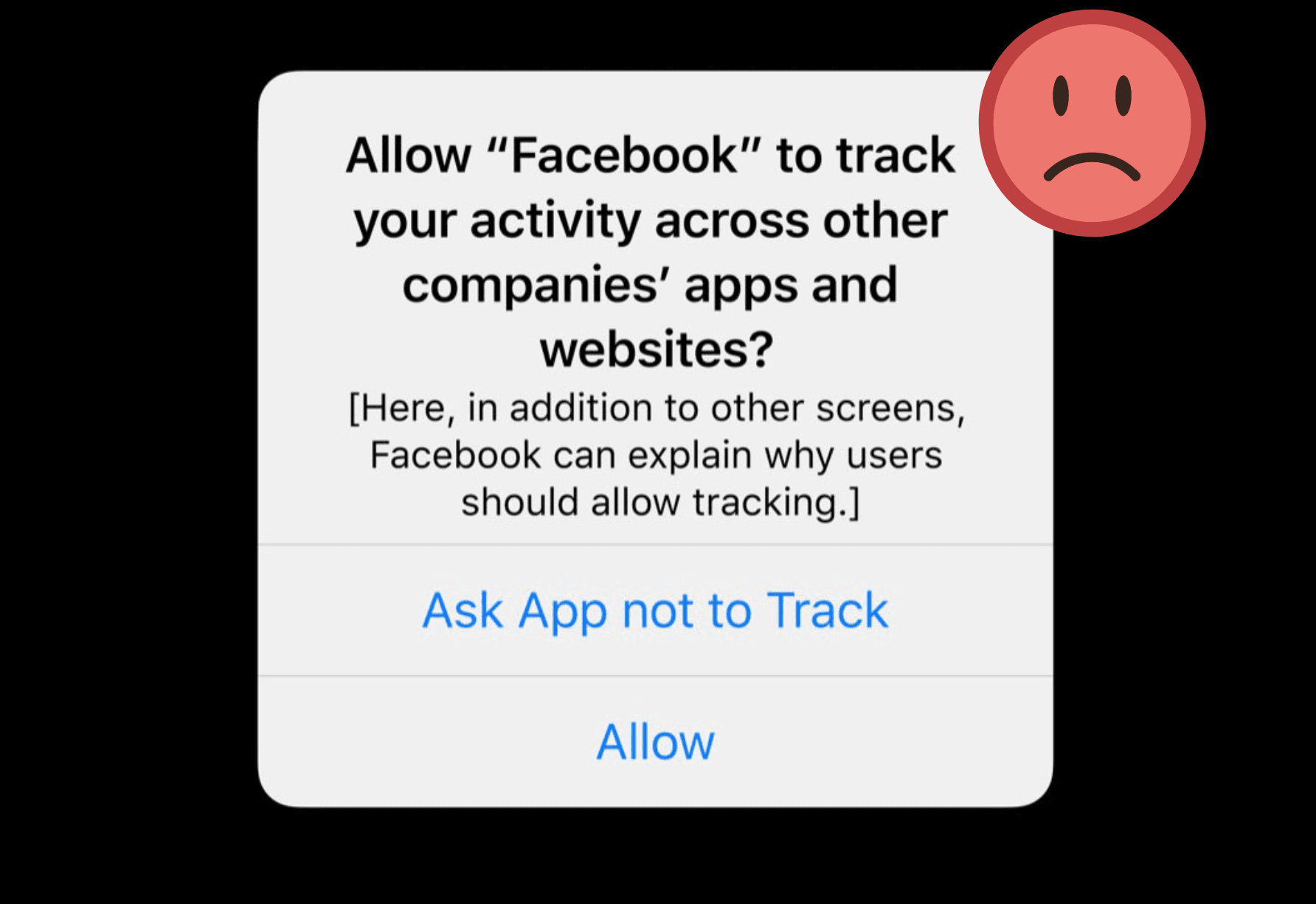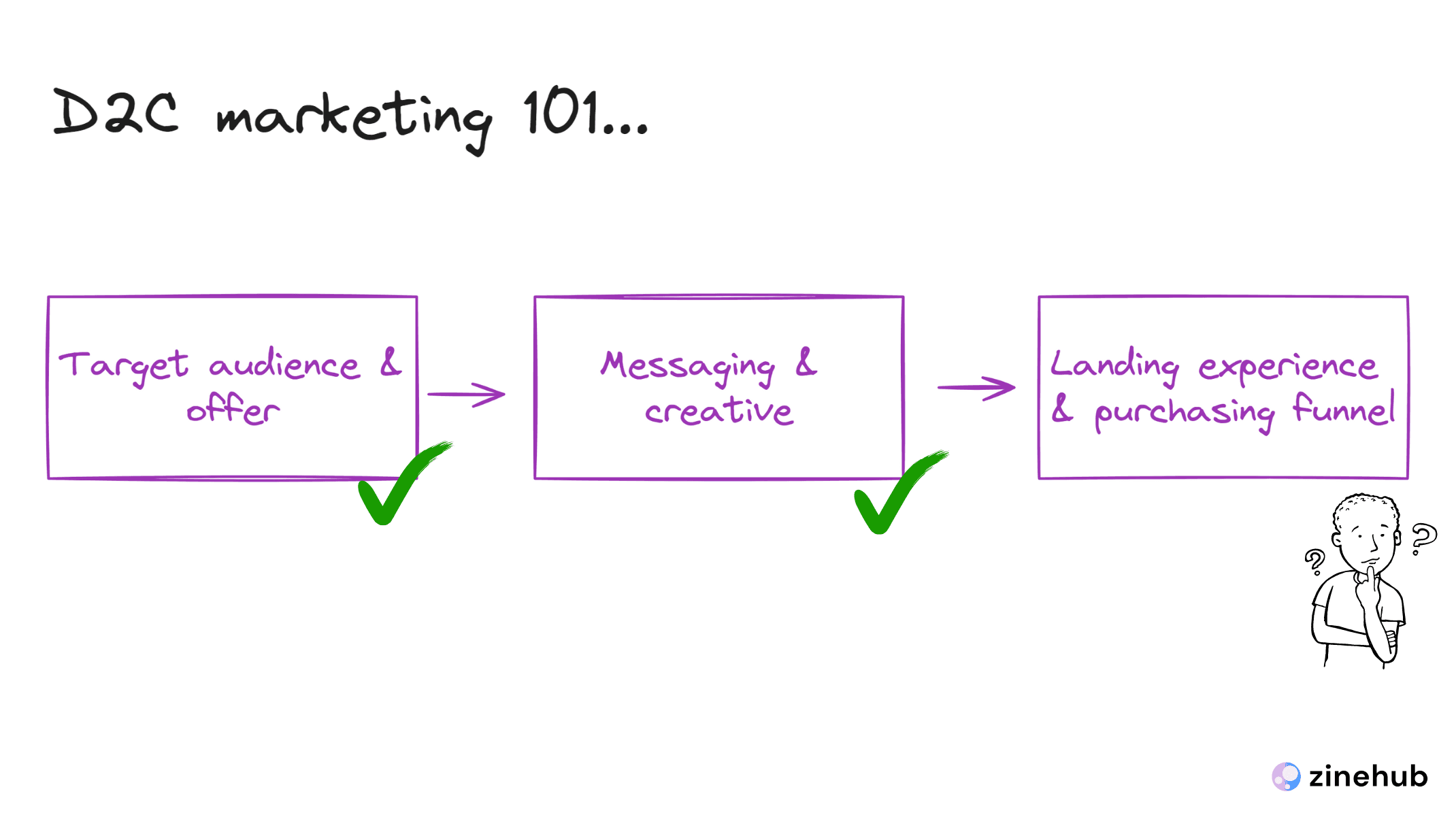D2C Landing Pages as Profitability Drivers
Dec 14, 2023
In eCommerce, the Black Friday Cyber Monday (BFCM) offers a glimpse on the industry’s sanity, the state of the industry and marketers’ priorities. On the sanity, some brands hit their meme game:

Out-of-your-mind creatives like this, paired with what feels like a recovering consumer sentiment, led to an overall solid season. Shopify merchants logged in staggering $9.3 billion revenues which is an increase of +20% vs. last year. This surge defied macro headwinds, signaling a positive trajectory for e-commerce after a very difficult period. As for ad spending, marketers funneled over 90% of their budgets into legacy platforms like Meta and Google. However, TikTok continued to rise in importance as an efficient ad platform not only for awareness but also conversions, with conversions rates jumping to 7.2% from 4.7% likely due to TikTok’s discount subsidies.
Drilling further down, Costs per Acquisition remain elevated but somewhat stable at around 25€ on Meta for both in US and EU. But marketers had to fight to keep their marketing efficiency under control, heavily pushing bundles and shifting their leads capturing and nurturing campaigns to the days and weeks leading up to BFCM. The Q4 2023 craze underscores the key challenge for D2C marketers, now more than ever: how to profitably acquire new customers in a tough macro environment, higher competition and in a privacy-centric world?
In this article, we want to lay out how acquiring new customers has changed since 2021, how marketers are dealing with these new challenges, through in some AI (obviously) and explain how we think marketers can improve their marketing efficiency through investing in landing experiences.
Customer acquisition since 2021

When D2C brands think about customer acquisition, they tend to distinguish between a time before 2021, and after. In 2021 Apple introduced their iOS 14 update and implemented their user privacy framework that requires app developers to get user permission before tracking their activity across app. This act significantly limited the availability of delicious user data that ad platforms like Meta feed into their algorithms for targeting users based on their web footprint. This data loss led to a decrease in ad efficiency, and thus fundamentally challenged how D2C brands scaled. In very simplified terms, the D2C playbook used to look as following: come up with an innovative product for a niche, sort out your supply chain, spin out a Shopify store, and start throwing money at the Meta algorithm that that magically brought you new customers at low cost, so brands could scale to xxm€ revenues in very short time.
The fundamental change in unit economics, paired with higher cost of capital and weak consumer sentiments, pushed many D2C brands out of business. Surviving brands mainly pursued two strategies: entering the world of “multi channel” and entering retail, leaving their “direct” legacy behind. But to keep the direct relationship with their customers, marketers had to step up their acquisition game. One winning approach turned out to be a stronger focus on ad creatives . Building a robust process around ad creative sourcing or production, testing and optimization allowed to somewhat counteract the negative effect of ATT and keep their CACs under control (Meta’s improvement of their targeting and attribution capabilities helped as well).
In addition, the rise of TikTok and short video led to UGC and creator content as a key source for high performing ads that offered an authentic solutions to high gloss and static ads. But as marketing tides go, consumers started to recognize that not all UGC is created equally, and as market forces go, every brand started to copy & paste the same hooks and creative formats, which again somewhat limited the efficiency of UGC. But let’s be clear here: we do not think that UGC is dead, it just needs to evolve and build upon opportunities AI is offering.
How AI is impacting customer acquisition
Leaving all hype around generative AI aside, content production and editing in marketing is evolving as one of the “low hanging” fruits for AI. Especially video editing still requires a lot of manual effort from marketers, time which can be freed up for strategizing and testing. Meta also started to implement in-platform features that allow easy content generation and editing of creatives, and we think that generative AI, paired with an endless stream of UGC and creator content, will further increase the diversity and abundance of highly personalized, engaging and cheap content for creatives.
Since 3rd party data is not easily available anymore for hyper personal targeting and retargeting, pushing out high quality, engaging and personalized content at scale, enabled by generative AI, will become a key skills by D2C marketers. So looking at the value chain of social ads, we think that generative AI will most heavily disrupt the messaging and creative parts while iterating on the target audience and offer will remain a key task to be completed by marketers. However, while landing page creation can be accelerated by AI for the most generic versions, there is a huge potential is aligning the post ad click experience with the ad creatives, and that’s where we see the big opportunity for the next years.
Why landing experiences are more important today

Building landing pages for social ads is nothing new. There are tons of agencies and no-code solutions promising to build high performing landing pages for different channels. However, with the abundance of creatives, having a seamless transition from ad click to landing page is becoming more and more important. Plus while short video and creator content is increasing dominating the ad creative landscape, landing page UX/UI still has to follow to the new media types. Who is not familiar with the experience of clicking on an entertaining, capturing video ad on Instagram and ending up on the brand’ home page, just feeling completely lost. Sophisticated marketers have recognized this opportunity and are iterating on finding the best landing experiences for their social ads. Especially video ads are based on short attention spans, which the landing experiences need to account for.
Since we started working on zinehub, it’s been a puzzle for us why marketers are investing so much time and resources on creative production, testing and improvement, but leave so much potential on the table by directing the expensively acquired traffic to static, non tailored landing pages. However, looking at how D2C teams operate and the tools they have at hand, it’s pretty obvious why it’s the case. D2C teams are small and strained since the market tone has changed from endless and cheap funding capital to profitable operations where everyone in the team has been drilled recite the definition of CM3 if woken up at 3am. Building landing pages is either expensive if agencies are involved, or still require a too high time investment when working with no-code landing page builders and running A/B tests. Plus existing landing page builders are not optimized for video content and not built to scale landing pages for dozens or hundreds of ads.
With zinehub, we are offering a solution for sophisticated eCom marketers who want to improve performance from their social ads by building unique landing experiences and purchasing funnels for all their video ads at scale and cost efficiently. We call it ‘landing experience’ because our battle tested designs are optimized for fast paced, video ads and offer full customization from ad click to check-out. Reach out if you want to learn how we do it and discuss case studies we have implemented already.
Conclusion
Profitably acquiring new customers remains a key challenge for any brand selling online, especially with less 3rd party data being available for ad targeting. After a time of investments into ad creatives and testing, which will be further fueled by generative AI, we believe that the most successful D2C marketers will need to align their ad creatives with landing experiences and purchasing funnel in order to profitably scale their business.
